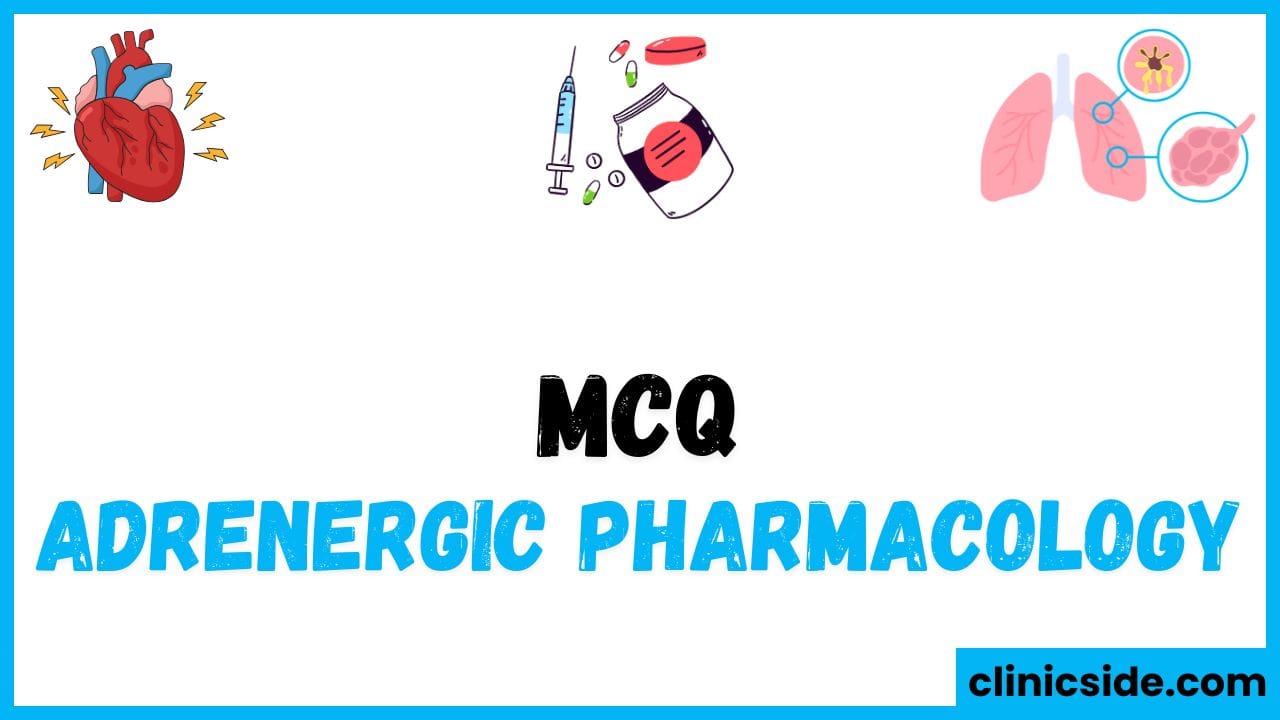Quiz
Available options: 1 to 20
Summary of Adrenergic Pharmacology MCQs
Role of Adrenergic Neurotransmitters
The primary neurotransmitter released by adrenergic neurons is norepinephrine, a crucial chemical in the sympathetic nervous system. Norepinephrine influences various bodily functions, including increasing heart rate, raising blood pressure, and promoting vasoconstriction. These effects prepare the body for rapid action in stressful situations. While dopamine and acetylcholine are also involved in neurotransmission, their roles differ significantly, with dopamine impacting the central nervous system and acetylcholine functioning in both the peripheral and central systems.
Functions of Adrenergic Receptors
The major adrenergic receptors include alpha-1, alpha-2, beta-1, and beta-2, each responsible for different physiological responses. Alpha-1 receptors are involved in vasoconstriction, which leads to an increase in blood pressure. They are also important in smooth muscle contraction in various tissues, including the bladder and eyes. In contrast, alpha-2 receptors reduce norepinephrine release and help in feedback inhibition of the autonomic nervous system. Beta-1 receptors, primarily found in the heart, increase heart rate and myocardial contractility. Meanwhile, beta-2 receptors are responsible for bronchodilation, which is crucial in conditions like asthma, improving airflow in the lungs.
Clinical Use of Beta-1 and Beta-2 Agonists
Beta-1 selective agonists, such as dobutamine, increase heart rate and enhance cardiac output, making them beneficial in managing heart failure and other heart-related issues. On the other hand, beta-2 agonists, including albuterol and terbutaline, are used in the treatment of respiratory conditions like asthma and chronic obstructive pulmonary disease (COPD). By stimulating beta-2 receptors in the lungs, these drugs help relax the airway muscles, improving airflow and alleviating respiratory symptoms.
The Role of Beta-Blockers
Beta-blockers such as propranolol are non-selective drugs that block both beta-1 and beta-2 receptors, leading to a reduction in heart rate and blood pressure. These medications are commonly used to treat conditions such as hypertension, arrhythmias, and heart failure. However, non-selective beta-blockers can have adverse effects, such as bronchoconstriction, making them inappropriate for individuals with asthma or other respiratory issues. Selective beta-1 blockers, such as atenolol and metoprolol, mainly affect the heart, reducing heart rate and blood pressure with fewer respiratory side effects. Pindolol, a beta-blocker with intrinsic sympathomimetic activity (ISA), offers additional benefits by partially stimulating beta receptors while still blocking them, helping to avoid bradycardia.
Alpha-1 and Alpha-2 Agonists in Treatment
Alpha-1 agonists, like phenylephrine, are primarily used as nasal decongestants. They act by causing vasoconstriction in the nasal passages, which reduces swelling and improves airflow. In contrast, alpha-2 agonists, such as clonidine, work by reducing sympathetic nervous system activity, which is beneficial in lowering blood pressure. Clonidine, by stimulating alpha-2 receptors in the brain, inhibits the release of norepinephrine, leading to a decrease in blood pressure.
Epinephrine in Emergency Medicine
Epinephrine, a powerful adrenergic agonist, is critical in emergency care, especially for treating anaphylaxis. It activates alpha-1, beta-1, and beta-2 receptors, causing vasoconstriction, increased heart rate, and bronchodilation, which helps reverse symptoms of anaphylaxis such as low blood pressure, bronchoconstriction, and respiratory distress. This combination of actions is also valuable in treating cardiac arrest and shock, where immediate support for the cardiovascular system is needed.
Reflex Bradycardia Due to Vasoconstriction
When drugs like phenylephrine stimulate alpha-1 receptors and cause vasoconstriction, a compensatory response known as reflex bradycardia can occur. This reflex reduces heart rate to counterbalance the rise in blood pressure caused by vasoconstriction. Understanding reflex bradycardia is important when using adrenergic drugs, especially those that affect vascular tone and cardiac output.
Dopamine’s Effect at Different Doses
Dopamine, another key adrenergic drug, has dose-dependent effects. At low doses, it stimulates dopamine receptors, improving renal blood flow. At moderate doses, it activates beta-1 receptors, which increases heart rate and myocardial contractility. At high doses, dopamine stimulates alpha-1 receptors, leading to vasoconstriction and elevated blood pressure. These varying effects make dopamine particularly useful in managing shock and cardiac failure, where different types of adrenergic effects may be required depending on the clinical scenario.
Therapeutic Use of Adrenergic Drugs
Adrenergic drugs play a crucial role in clinical practice. Epinephrine, dopamine, and phenylephrine are often used in emergency settings to treat conditions like shock, anaphylaxis, and cardiac arrest. Beta-agonists such as albuterol are essential in the management of asthma and other respiratory disorders. Beta-blockers like propranolol and metoprolol are critical in managing heart conditions and hypertension, while alpha-agonists like phenylephrine are commonly used to relieve nasal congestion. Understanding these drugs’ mechanisms and clinical applications is vital for optimizing patient outcomes.
Conclusion
Adrenergic pharmacology is integral to modern medicine, with drugs affecting alpha and beta receptors used to treat a range of conditions, from respiratory diseases to heart failure and anaphylaxis. By understanding the action of these drugs, healthcare providers can offer targeted treatment while minimizing side effects, ensuring that patients receive the most effective and safe therapies for their specific needs.





